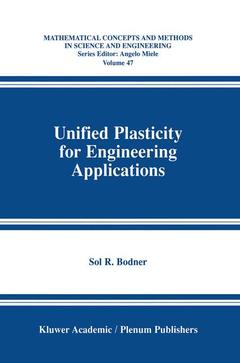Unified Plasticity for Engineering Applications, Softcover reprint of the original 1st ed. 2002 Mathematical Concepts and Methods in Science and Engineering Series, Vol. 47
Langue : Anglais
Auteur : Bodner Sol R.

Considerably simplified models of macroscopic material behavior, such as the idealization for metals of elastic-time independent plastic response with a yield (onset) criterion, have served the engineering profession well for many years. They are still basic to the design and analysis of most structural applications. In the need to use materials more effectively, there are circumstances where those traditional models are not adequate, and constitutive laws that are more physically realistic have to be employed. This is especially relevant to conditions where the inherent time dependence of inelastic deformations, referred to as "viscoplasticity", is pronounced such as at elevated temperatures and for high strain rates. Unified theories of elastic-viscoplastic material behavior, which are primarily applicable for metals and metallic alloys, combine all aspects of inelastic response into a set of time dependent equations with a single inelastic strain rate variable. For such theories, creep under constant stress, stress relaxation under constant strain, and stress-strain relations at constant rates are each special cases of a general formulation. Those equations mayor may not include a yield criterion, but models which do not separate a fully elastic region from the overall response could be considered "unified" in a more general sense. The theories have reached a level of development and maturity where they are being used in a number of sophisticated engineering applications. However, they have not yet become a standard method of material representation for general engineering practice.
1. Formulation of a Unified Constitutive Theory of Elastic-Viscoplastic Behavior.- 1.1. Introduction.- 1.2. Concepts and Basic Equations.- 1.3. Extensions and General Applications of the Basic Equations.- 1.3.1. Variable Rate of Hardening/Cyclic Loading.- 1.3.2. Thermodynamic Considerations; Stored Energy of Cold Work.- 1.3.3. Strain Rate Dependence of Hardening Rate.- 1.3.4. Creep of Metals.- 1.3.5. Continuum Damage as a State Variable.- 1.3.6. Non-Proportional Loadings.- 1.3.7. Viscoplastic Buckling.- 1.3.8. Rate Sensitivity in Dynamic Plasticity Problems.- 1.4. Integration of Constitutive Equations.- 2. Specific Applications.- 2.1. Material Constants and Applications.- 2.1.1. Background.- 2.1.2. Methods for Determination of Material Constants.- 2.1.3. Examples.- 3. Commentaries.- 3.1. Status of the B-P Constitutive Theory.- 3.2. Further Developments.- 3.2.1 Large Deformations.- 3.2.2 Anisotropic Materials.- Appendix - Computer Program.- References.
Date de parution : 09-2012
Ouvrage de 115 p.
15.5x23.5 cm
Disponible chez l'éditeur (délai d'approvisionnement : 15 jours).
Prix indicatif 105,49 €
Ajouter au panierDate de parution : 12-2001
Ouvrage de 114 p.
Mots-clés :
deformation; development; materials; metals; modeling; plasticity
© 2024 LAVOISIER S.A.S.



